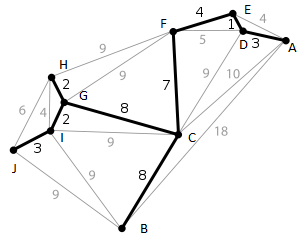
A minimum spanning tree is defined as:
Given a connected, undirected graph, a spanning tree of that graph is a subgraph that is a tree and connects all the vertices together. A single graph can have many different spanning trees. We can also assign a weight to each edge, which is a number representing how unfavorable it is, and use this to assign a weight to a spanning tree by computing the sum of the weights of the edges in that spanning tree. A minimum spanning tree (MST) or minimum weight spanning tree is then a spanning tree with weight less than or equal to the weight of every other spanning tree. - Wikipedia
Write a method public void printMinimumSpanningTree() that prints a minimum spanning tree of a given graph, and the total cost (total of traveled weights) of the tree. A graph can have multiple minimum spanning trees that are equal in cost.
Graph graph=new Graph();
Node a=new Node(0);
Node b=new Node(1);
Node c=new Node(2);
Node d=new Node(3);
Node e=new Node(4);
Node f=new Node(5);
Node g=new Node(6);
Node h=new Node(7);
Node i=new Node(8);
Node j=new Node(9);
graph.addEdge(a,b,18);
graph.addEdge(a,c,10);
graph.addEdge(a,d,3);
graph.addEdge(a,e,4);
graph.addEdge(b,j,9);
graph.addEdge(b,i,9);
graph.addEdge(c,b,8);
graph.addEdge(c,i,9);
graph.addEdge(c,g,8);
graph.addEdge(d,e,1);
graph.addEdge(d,c,9);
graph.addEdge(d,f,5);
graph.addEdge(e,f,4);
graph.addEdge(f,c,7);
graph.addEdge(f,g,9);
graph.addEdge(f,h,9);
graph.addEdge(g,h,2);
graph.addEdge(g,i,2);
graph.addEdge(h,i,4);
graph.addEdge(h,j,6);
graph.addEdge(i,j,3);
// Define a "Prim Edge" as an edge with one node in the spanning
// tree, and one node not
func primsAlg()
tmp: Graph <- Graph()
tmp.add(random node from this)
while (tmp.nodes != this.nodes)
tmpEdge <- smallestPrimEdge(tmp)
tmp.edges.add(tmpEdge.A, tmpEdge.B, tmpEdge.Weight)
endwhile
STDOUT.println(tmp)
endfunc
func smallestPrimEdge(g: Graph)
min: int <- 99999999;
tmp: Edge <- random edge
other: Set <- g.nodes
for (edge e in edges)
a: Node <- e.A
b: Node <- e.B
if (other has a and not b or
other has b and not a)
if (e.Weight < min)
tmp <- e
min <- e.Weight
endif
endif
endfor
return tmp
endfuncA cycle in a graph is a series of nodes in a graph such that there is a connected path going from and leading back to the same node. Within graph theory there are several types of cycles, but we will focus solely on cycles that start and end at the same node.
Write a method public boolean hasCycles() that tests if a graph has cycles.